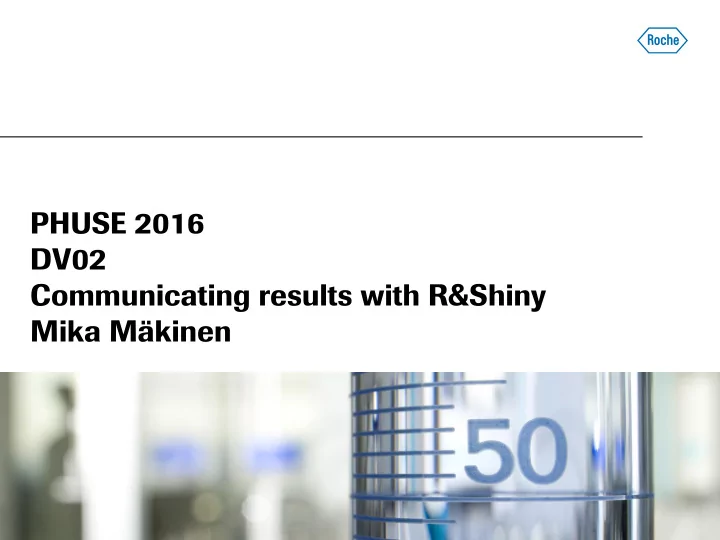

PHUSE 2016 DV02 Communicating results with R&Shiny Mika Mäkinen
Introduction 1. Communicating results (not only producing outputs) 2. Cases from a real study 3. Visualization concept
Motivation for interactive & better visualizations • Responsibility of the function that has access to data & knowledge of technology – There is an unmet need for better visualizations from stakeholders – Better access & presentation might lead to discoveries • it is not always easy for the stakeholder to specify exactly what the question of interest is • Interactive visualization enables communication – User communicates with the data – Interactive visualization facilitates discussion between stakeholder and programmer • Other industries are doing it – Stakeholders are used to modern day application feel and look – Benchmarking to improve
Inspiration & benchmark • Civilization IV (2005) • Booking.com • Pokemon dashboard – http://jkunst.com/flexdashboard-highcharter-examples/pokemon/
Inspiration & benchmark • Civilization IV (2005) • Booking.com • Pokemon dashboard – http://jkunst.com/flexdashboard-highcharter-examples/pokemon/
Inspiration & benchmark • Civilization IV (2005) • Booking.com • Pokemon dashboard – http://jkunst.com/flexdashboard-highcharter-examples/pokemon/
From paper to browser • Many questions can be answered through interaction (e.g. Booking change of days) • Intuitive story telling (Civilization) • Quick access to the data (Booking) • Quick to publish & distribute (Pokemon) • Use of graph objects within visualization (Pokemon) • Drill down (Pokemon, Booking)
R/Shiny • R/Shiny has a very good pipeline from programming to publishing – Modular programming enables reactivity – Distribution of visualizations is easy with server. • R has great libraries for graphs – Base, grid, trellis, ggplot2 • Shiny has plenty of ready to be used templates – http://shiny.rstudio.com/gallery/ • Visualizations can be produced with other software as well – Spotfire , Java script, VBA… etc.
Simulated data • Structure – Events (Rash, Bruise, Swelling, Cut) – Treatments (Gel, Cream, Tablet, Capsule) • Structure similar to any event data • Used mostly to investigate relationship between event and treatment – E.g. whether it is feasible to say that day 65 Rash was treated with day 69 capsule. patientNum eventDay event eventCat bodyLocation 100 55 Swelling Event 8 100 65 Rash Event 6 100 56 Gel Treatment NA 100 69 Capsule Treatment NA
INTERACTIVITY IN MULTIPLE EVENT PLOT
INTERACTIVITY IN MULTIPLE EVENT PLOT • Real visualization – Descriptive numbers to follow the collection of data – Many options to subset the data • Visualization was used to share data as the study was ongoing – New disease area for company – ePRO data – Non-interventional study (NIS) to help to understand the data – Refreshed as data arrived
INTERACTIVITY IN MULTIPLE EVENT PLOT • Within biometrics – Helped statisticians and programmers to communicate difference between expected and actual data. – Helped to communicate data problems to data management • Outside biometrics – Access to visualization was fast after data arrival – Visualization helped to see the need to refine the end point definitions for up coming studies – Clinical science was able to identify unexpected behaviors to focus medical review – Most likely some official adhoc request were avoided as team was able to address questions interactively
VISUALIZATION OF CHANGE IN DEFINITIONS
VISUALIZATION OF CHANGE IN DEFINITIONS Real visualization • – More options to change definition – Descriptive table – Searchable list of events excluded/included as treated • Visualization was used to asses the definition of treated event. • Visualization facilitated discussion. • Helped to see the need of change of definition of treated event. • Listing data points in side of visualization helps stakeholders to understand handling of individual observation that they are interested.
CUSTOM PLOT TO TELL THE STORY OF THE STUDY
CUSTOM PLOT TO TELL THE STORY OF THE STUDY • Engaging visualization for all stakeholders • Story of the study, combining multiple domains – Heatmap type of presentation – Numbers/scales could be added to add information – Comparison between groups side by side • Any vector graphic can be imported and used as base for visualization • Method could be used with much more detailed graphics
Summary • Interactive visualization facilitates communication. – Communication helps programmer to understand and contribute in the project. • Server based visualizations let users to access the most recent data when there is a need. • R/Shiny has good tools for interactive visualizations.
Doing now what patients need next
Recommend
More recommend